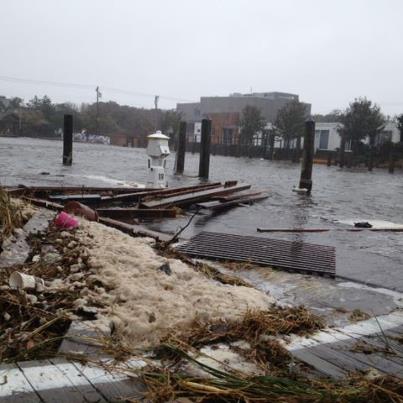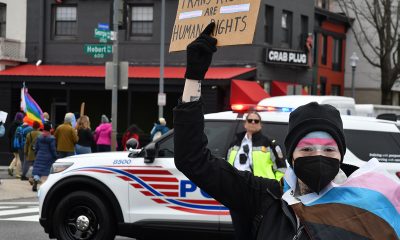National
Gay N.J. activist: Sandy left behind ‘massive destruction’
Superstorm brought widespread devastation to both New Jersey and New York


Bay water inundates the harbor in Fire Island Pines, N.Y., on Oct. 29 (Photo courtesy of Karen Boss)
The head of New Jersey’s statewide LGBT advocacy organization on Wednesday said Superstorm Sandy devastated his state.
“Hurricane Sandy has left massive destruction in her aftermath,” said Garden State Equality Chair Steven Goldstein in a YouTube video shot on a street in Teaneck in Bergen County with down trees and power lines in the background.
Goldstein urged his organization’s members and supporters to keep in regular contact with the elderly, young people and those with disabilities directly impacted by the storm who may need someone to pick up their prescriptions or buy them other basic supplies.
“On behalf of our entire Board of Directors, I extend to you our love, our prayers and most profound gratitude for being there for one another during this time of need.”
Sandy’s storm surge inundated large swaths of the New Jersey coastline, New York City, the South Shore of Long Island and Fire Island as it made landfall near Atlantic City, N.J., on Monday night. The storm killed at least 90 people in the United States and dozens of others in the Caribbean.
Villas, N.J., residents Vince Grimm and Will Kratz, whom the Washington Blade interviewed in August shortly after they celebrated their 51st anniversary, rode out Sandy in their bay front home north of Cape May. The couple lost power and water during the storm, but Grimm told friends in an e-mail he and Kratz have been able to run a generator and their gas-powered fireplace.
The storm did not damage the couple’s home and property.
“Our beach is a disaster and we lost our sand fences, but the dune is intact considering we got hit [during] a high tide with a full moon,” said Grimm. “Actually our street, 11 blocks long, has virtually no damage considering we are sitting on a sand dune along the bay.”
Sandy’s winds ‘unlike anything I’ve heard’
The storm killed at least 37 people in New York City, while a fast-moving fire destroyed more than 100 homes in the flooded Breezy Point neighborhood of Queens late on Monday.
A record storm surge that nearly topped 14 feet in lower Manhattan inundated large swaths of the five boroughs, subway tunnels under the East and Hudson Rivers and the Queens-Midtown and High L. Carey Tunnels that link Manhattan with Queens and Brooklyn respectively.
A limited number of subway and commuter train lines are once again running in portions of the city and metropolitan area, but bus service below 23rd Street in Manhattan remains suspended at night because the lack of electricity has created dangerous driving conditions. More than a quarter of a million customers in Manhattan remained in the dark as of 4:30 a.m. on Thursday.
“It’s been a crazy, crazy few days here,” gay New York City Council candidate Corey Johnson told the Blade on Wednesday. His apartment on West 15th Street in Manhattan’s Chelsea neighborhood is close to the Eighth Avenue building that lost its facade during the height of the storm. “All I could hear was howling winds. It was unlike anything I’ve heard in my 12 years in New York.”
Cindi Creager, the former communications director of the LGBT Community Center in Greenwich Village, was inside her West Village apartment with her wife during the storm. The couple is currently staying with a friend who lives on Manhattan’s Upper West Side, but Creager told the Blade she feels fortunate she and her wife escaped the storm unscathed.
“The wind was howling and whipping [outside] the window. And it was scary,” she said. “We had power and we didn’t and it was total darkness outside the window. And that’s when it felt very scary. You just start to realize how fleeting life can be. We did very well considering.”
Cathy Renna of Renna Communications rode out Sandy in her centuries old farmhouse on Shelter Island between Long Island’s North and South Forks. She told the Blade local utility crews restored the electricity to her home roughly 24 hours after the worst of the storm had passed.
Sandy brought several large trees down across Shelter Island, but Renna stressed she feels she and her family “were really lucky.”
“I grew up on Long Island,” she said, noting her sister’s friend who lives in Lindenhurst along the Great South Bay in southwestern Suffolk County lost everything to the storm. “I have never, ever seen winds like that. It was terrifying, but it was only for a few hours.”
Storm devastates Fire Island, forces LGBT groups to close
Sandy caused widespread flooding and severe beach erosion throughout Fire Island. Dozens of oceanfront homes in Fire Island Pines sustained damage from the storm surge. The high tides also damaged bulkheads and bay front board walks in the hamlet and neighboring Cherry Grove.
The storm also forced the Empire State Pride Agenda, the National Gay and Lesbian Task Force, the Gay and Lesbian Alliance Against Defamation, the International Gay and Lesbian Human Rights Commission and other LGBT advocacy groups to close their lower Manhattan offices because of the power outage and in some cases flooding.
“Our New York-based staff members are safe and working from home with limited resources,” said GLAAD spokesperson Seth Adam on the organization’s website on Tuesday. “Today, our thoughts are with all those families affected by Hurricane Sandy, as well as first responders working to keep us safe.”
Officials cancelled the city’s annual Halloween parade in Greenwich Village. The storm also derailed Splash Bar and other lower Manhattan gay bars and clubs’ holiday festivities because of the blackout. Restaurants and other businesses in the Hell’s Kitchen neighborhood west of Times Square that did not lose electricity during Sandy remain open.
“Day 3 of no power,” said Gym Sports Bar, which is on Eighth Avenue in Chelsea, in a message to patrons. “Our thoughts are with you out there. As soon as our lights are back on we will be back on the field. Stay safe out there Gym peeps.”
Restoring power and full subway service remain New York City officials’ top priorities.
“The subway lines are really the veins, arteries and lifeblood of the city,” said Johnson. “People are basically stuck unless they’re going to work or are able to get on a bus.”
Lesbian New York City Council candidate Yetta Kurland, who said her building has run out of the water because of the lack of electricity, said the closure of New York University Langone Medical Center and Bellevue Hospital because of flooding has left lower Manhattan residents more vulnerable. Kurland also pointed out people with disabilities and others who are unable to leave their apartments are unable to obtain food, water and ice at Union Square and other distribution points.
“There’s a large relief effort,” she said. “The city’s doing a great job at this point, but there are a lot of homebound people who cannot get to Union Square.”
Gay City Councilmember Daniel Dromm said the situation in his Queens district that includes the neighborhoods of Jackson Heights and Elmhurst “is pretty much okay” outside of downed trees. Overcrowded subway stations and gas shortages have become a problem, but Dromm said the gay bars and other businesses along bustling Roosevelt Avenue that were closed during the storm have since re-opened.
“Everything is back up and operational in Jackson Heights itself,” said Dromm. “We were very lucky.”
Gay New Yorkers persevere in spite of Sandy
Congregation Beit Simchat Torah, which is the country’s largest LGBT synagogue, will hold its weekly Shabbat service by candlelight at a Manhattan church later on Friday. Its group for older congregants will meet at a nearby diner beforehand for dinner.
Elmo, a restaurant on Seventh Avenue in Chelsea, on Wednesday served drinks in spite of the lack of electricity.
Even as New Yorkers try to return to some sense of normalcy, they continue to reflect upon the storm that devastated their city.
“You go from this thriving city uptown to just a ghost town downtown, which is really scary,” said Creager, who briefly returned to her apartment on Wednesday to pick up more clothes and other belongings. “There was a lot of traffic yesterday going up and down the West Side Highway because there’s no subway. There’s that feeling in the air, even on the Upper West Side like something major has happened.”
Dromm, who taught in the city’s public schools for 25 years until his 2009 election to the City Council, said he has “never seen anything like” Sandy “in my life in Queens.” He also applauded New York Gov. Andrew Cuomo for raising the issue of climate change during the storm’s aftermath.
“It’s a very important question,” said Dromm. “It’s really scary when you think about lower Manhattan—areas of lower Manhattan being flooded out like that. Government wasn’t even able to really operate in this storm. It’s very, very scary.”
The White House
HHS to restrict gender-affirming care for minors
Directive stems from President Donald Trump’s Jan. 28 executive order

The U.S. Department of Health and Human Services announced Thursday that it will pursue regulatory changes that would make gender-affirming healthcare for transgender children more difficult, if not impossible, to access.
The shift in federal healthcare policy stems directly from President Donald Trump’s Jan. 28 executive order, Protecting Children From Chemical and Surgical Mutilation, which formally establishes U.S. opposition to gender-affirming care and pledges to end federal funding for such treatments.
The executive order outlines a broader effort to align HHS with the Trump–Vance administration’s policy goals and executive actions. Those actions include defunding medical institutions that provide gender-affirming care to minors by restricting federal research and education grants, withdrawing the 2022 HHS guidance supporting gender-affirming care, requiring TRICARE and federal employee health plans to exclude coverage for gender-affirming treatments for minors, and directing the Justice Department to prioritize investigations and enforcement related to such care.
HHS has claimed that gender-affirming care can “expose them [children] to irreversible damage, including infertility, impaired sexual function, diminished bone density, altered brain development, and other irreversible physiological effects.” The nation’s health organization published a report in November, saying that evidence on pediatric gender-affirming care is “very uncertain.”
The Centers for Medicare and Medicaid Services is now in the process of proposing new rules that would bar hospitals from performing what the administration describes as sex-rejecting procedures on children under age 18 as a condition of participation in Medicare and Medicaid programs. Nearly all U.S. hospitals participate in Medicare and Medicaid. HHS said that “this action is designed to ensure that the U.S. government will not be in business with organizations that intentionally or unintentionally inflict permanent harm on children.”
Health and Human Services Secretary Robert F. Kennedy Jr. released a statement alongside the announcement.
“Under my leadership, and answering President Trump’s call to action, the federal government will do everything in its power to stop unsafe, irreversible practices that put our children at risk,” Kennedy said. “This administration will protect America’s most vulnerable. Our children deserve better — and we are delivering on that promise.”
Those claims stand in direct opposition to the positions of most major medical and healthcare organizations.
The American Medical Association, the nation’s largest and most influential physician organization, has repeatedly opposed measures that restrict access to trans healthcare.
“The AMA supports public and private health insurance coverage for treatment of gender dysphoria and opposes the denial of health insurance based on sexual orientation or gender identity,” a statement on the AMA’s website reads. “Improving access to gender-affirming care is an important means of improving health outcomes for the transgender population.”
Jennifer Levi, senior director of transgender and queer rights at GLBTQ Legal Advocates and Defenders, warned the proposed changes would cause significant harm.
“Parents of transgender children want what all parents want: to see their kids thrive and get the medical care they need. But this administration is putting the government between patients and their doctors. Parents witness every day how their children benefit from this care — care backed by decades of research and endorsed by major medical associations across the country. These proposed rules are not based on medical science. They are based on politics. And if allowed to take effect will serve only to drive up medical costs, harm vulnerable children, and deny families the care their doctors say they need. These rules elevate politics over children — and that is profoundly unAmerican.”
Human Rights Campaign President Kelley Robinson echoed Levi’s sentiments.
“The Trump administration is relentless in denying health care to this country, and especially the transgender community. Families deserve the freedom to go to the doctor and get the care that they need and to have agency over the health and wellbeing of their children,” Robinson said. “But these proposed actions would put Donald Trump and RFK Jr. in those doctor’s offices, ripping health care decisions from the hands of families and putting it in the grips of the anti-LGBTQ+ fringe. Make no mistake: these rules aim to completely cut off medically necessary care from children no matter where in this country they live. It’s the Trump administration dictating who gets their prescription filled and who has their next appointment canceled altogether.
The announcement comes just days after U.S. Rep. Marjorie Taylor Greene (R-Ga.) advanced legislation in Congress that would make it a felony to provide gender-affirming care to a child.
The White House
As house Democrats release Epstein photos, Garcia continues to demand DOJ transparency
Blade this week sat down with gay House Oversight Committee ranking member

Democrats on the House Oversight Committee have released new photos from Jeffrey Epstein’s email and computer records, including images highlighting the relationship between President Donald Trump and the convicted sex offender.
Epstein, a wealthy financier, was found guilty of procuring a child for prostitution and sex trafficking, serving a 13-month prison sentence in 2008. At the time of his death in prison under mysterious circumstances, he was facing charges of sex trafficking and conspiracy to traffic minors.
Among those pictured in Epstein’s digital files are Trump, former President Bill Clinton, former Trump adviser Steve Bannon, actor and director Woody Allen, economist Larry Summers, lawyer Alan Dershowitz, entrepreneurs Richard Branson and Bill Gates, and Andrew Mountbatten-Windsor.
One photo shows Trump alongside Epstein and a woman at a Victoria’s Secret party in New York in 1997. American media outlets have published the image, while Getty Images identified the woman as model Ingrid Seynhaeve.
Oversight Committee Democrats are reviewing the full set of photos and plan to release additional images to the public in the coming days and weeks, emphasizing their commitment to protecting survivors’ identities.
With just a week left for the Justice Department to publish all files related to Epstein following the passage of the Epstein Files Transparency Act, which requires the Justice Department to release most records connected to Epstein investigations, the Washington Blade sat down with U.S. Rep. Robert Garcia (D-Calif.), the ranking member on the Oversight Committee to discuss the current push the release of more documents.
Garcia highlighted the committee’s commitment to transparency and accountability.

“We’ve said anything that we get we’re going to put out. We don’t care who is in the files … if you’ve harmed women and girls, then we’ve got to hold you accountable.”
He noted ongoing questions surrounding Trump’s relationship with Epstein, given their long history and the apparent break in friendship once Trump assumed public office.
“There’s been a lot of questions about … Donald Trump and Jeffrey Epstein. They were best friends for 10 years … met women there and girls.”
Prior to Trump’s presidency, it was widely reported that the two were friends who visited each other’s properties regularly. Additional reporting shows they socialized frequently throughout the 1990s and early 2000s, attending parties at Trump’s Mar-a-Lago resort in Florida and Epstein’s residences. Flight logs from an associate’s trial indicate Trump flew on Epstein’s private jet multiple times, and Epstein claimed Trump first had sex with his future wife, Melania Knauss, aboard the jet.
“We’ve provided evidence … [that leads to] questions about what the relationship was like between Donald Trump and Jeffrey Epstein.”
Garcia stressed the need for answers regarding the White House’s role in withholding information, questioning the sudden change in attitude toward releasing the files given Trump’s campaign promises.
“Why is the White House trying to cover this up? So if he’s not covering for himself … he’s covering up for his rich friends,” Garcia said. “Why the cover up? Who are you hiding for? I think that’s the question.”
He confirmed that Trump is definitively in the Epstein files, though the extent remains unknown, but will be uncovered soon.
“We know that Trump’s in them. Yeah, he’s been told. We know that Trump’s in them in some way. As far as the extent of it … we don’t know.”
Garcia emphasized accountability for all powerful figures implicated, regardless of financial status, political party, or personal connections.
“All these powerful men that are walking around right now … after abusing, in some cases, 14‑ and 15‑year‑old girls, they have to be held accountable,” he said. “There has to be justice for those survivors and the American public deserves the truth about who was involved in that.”
He added that while he is the ranking member, he will ensure the oversight committee will use all available political tools, including subpoenas — potentially even for the president.
“We want to subpoena anyone that we can … everyone’s kind of on the table.”
He also emphasized accountability for all powerful figures implicated, regardless of financial status, political party, or relationship with the president.
“For me, they’re about justice and doing the right thing,” Garcia said. “This is about women who … were girls and children when they were being abused, trafficked, in some cases, raped. And these women deserve justice.”
“The survivors are strong.”
Deputy White House Press Secretary Abigail Jackson issued a statement regarding the release the photos, echoing previous comments from Republicans on the timing and framing of the photos by the Oversight Committee.
“Once again, House Democrats are selectively releasing cherry-picked photos with random redactions to try and create a false narrative,” Jackson said.
“The Democrat hoax against President Trump has been repeatedly debunked and the Trump administration has done more for Epstein’s victims than Democrats ever have by repeatedly calling for transparency, releasing thousands of pages of documents, and calling for further investigations into Epstein’s Democrat friends,”
In a press release on Friday, Garcia called for immediate DOJ action:
“It is time to end this White House cover-up and bring justice to the survivors of Jeffrey Epstein and his powerful friends. These disturbing photos raise even more questions about Epstein and his relationships with some of the most powerful men in the world. We will not rest until the American people get the truth. The Department of Justice must release all the files, NOW.”





(Photo courtesy of the U.S. House Oversight Committee)
The White House
White House deadnames highest-ranking transgender official
Rachel Levine’s portrait altered at HHS

Admiral Rachel Levine — the first transgender person ever confirmed by the U.S. Senate and the highest-ranking trans official in American history — had her official portrait in the Humphrey Building altered, with staff replacing her correct name with her deadname, the name she has not used since 2011.
NPR first reported the change, and an HHS spokesperson confirmed to the outlet that Levine’s portrait had recently been altered. A digital photograph obtained by NPR shows Levine’s former (male) name typed on a placard beneath the portrait, placed under the glass of the frame.
Levine served as a four-star admiral in the U.S. Public Health Service Commissioned Corps under the Biden-Harris administration and was appointed the 17th assistant secretary for health.
During her tenure, Levine oversaw the Commissioned Corps and helped lead national public-health initiatives, including the federal COVID-19 response and vaccination strategy; efforts to address rising syphilis infection rates; HIV/AIDS prevention and treatment programs; and strategies to combat the opioid epidemic, particularly through expanded harm-reduction approaches for the communities most affected.
The Trump-Vance administration’s decision to publicly deadname Levine is widely viewed within the trans community as demeaning and disrespectful. The move comes amid a series of federal policy reversals targeting LGBTQ Americans, particularly trans youth seeking gender-affirming care.
Those actions include: weakening workplace protections for LGBTQ employees; limiting restroom access; downgrading gender-identity discrimination cases; pressuring hospitals to end gender-affirming care; cutting HIV research and prevention funding; removing LGBTQ crisis resources; restricting access to trans-inclusive medical policies for veterans and young people; supporting trans sports bans and threatening funding for teams that include trans athletes; and forcing schools and universities to eliminate DEI and LGBTQ offices, inclusive curricula, gender-neutral bathrooms, and books or training materials addressing LGBTQ issues.
The Trump–Vance administration has also expanded federal censorship by removing LGBTQ language from surveys, agency websites, Smithsonian materials, and human-rights reports; blocking Pride recognitions; creating federal communications that misgender trans women; imposing passport and travel barriers for trans Americans; lifting protections for trans service members; limiting benefits and care for LGBTQ veterans; and pressuring states, universities, and hospitals to end trans-inclusive policies under threat of losing federal research, education, or Medicaid funds. The administration has additionally deported LGBTQ asylum seekers to unsafe conditions, removed LGBTQ issues from global human-rights reporting, and escalated anti-trans rhetoric at public events.
These actions stand in stark contrast to Levine’s public-health record. As assistant secretary for health, she worked to expand LGBTQ+ health data collection, promote equitable vaccine distribution, strengthen national health-equity initiatives, and reduce care disparities experienced by historically underserved communities, including LGBTQ populations. Within HHS, she led councils and task forces dedicated to reducing structural barriers to care and improving community outcomes.
Before joining the federal government, Levine oversaw health and safety for nearly 13 million residents as Pennsylvania’s physician general from 2015–2017 and as Pennsylvania secretary of health from 2018–2021.

Asked by NPR about the alteration of her official portrait, Levine responded that it had been an honor to serve as assistant secretary for health, adding: “I’m not going to comment on this type of petty action.”



















